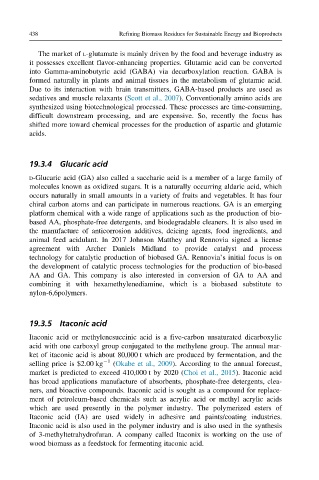Page 481 - Refining Biomass Residues for Sustainable Energy and Bioproducts
P. 481
438 Refining Biomass Residues for Sustainable Energy and Bioproducts
The market of L-glutamate is mainly driven by the food and beverage industry as
it possesses excellent flavor-enhancing properties. Glutamic acid can be converted
into Gamma-aminobutyric acid (GABA) via decarboxylation reaction. GABA is
formed naturally in plants and animal tissues in the metabolism of glutamic acid.
Due to its interaction with brain transmitters, GABA-based products are used as
sedatives and muscle relaxants (Scott et al., 2007). Conventionally amino acids are
synthesized using biotechnological processed. These processes are time-consuming,
difficult downstream processing, and are expensive. So, recently the focus has
shifted more toward chemical processes for the production of aspartic and glutamic
acids.
19.3.4 Glucaric acid
D-Glucaric acid (GA) also called a saccharic acid is a member of a large family of
molecules known as oxidized sugars. It is a naturally occurring aldaric acid, which
occurs naturally in small amounts in a variety of fruits and vegetables. It has four
chiral carbon atoms and can participate in numerous reactions. GA is an emerging
platform chemical with a wide range of applications such as the production of bio-
based AA, phosphate-free detergents, and biodegradable cleaners. It is also used in
the manufacture of anticorrosion additives, deicing agents, food ingredients, and
animal feed acidulant. In 2017 Johnson Matthey and Rennovia signed a license
agreement with Archer Daniels Midland to provide catalyst and process
technology for catalytic production of biobased GA. Rennovia’s initial focus is on
the development of catalytic process technologies for the production of bio-based
AA and GA. This company is also interested in conversion of GA to AA and
combining it with hexamethylenediamine, which is a biobased substitute to
nylon-6,6polymers.
19.3.5 Itaconic acid
Itaconic acid or methylenesuccinic acid is a five-carbon unsaturated dicarboxylic
acid with one carboxyl group conjugated to the methylene group. The annual mar-
ket of itaconic acid is about 80,000 t which are produced by fermentation, and the
selling price is $2.00 kg 21 (Okabe et al., 2009). According to the annual forecast,
market is predicted to exceed 410,000 t by 2020 (Choi et al., 2015). Itaconic acid
has broad applications manufacture of absorbents, phosphate-free detergents, clea-
ners, and bioactive compounds. Itaconic acid is sought as a compound for replace-
ment of petroleum-based chemicals such as acrylic acid or methyl acrylic acids
which are used presently in the polymer industry. The polymerized esters of
Itaconic acid (IA) are used widely in adhesive and paints/coating industries.
Itaconic acid is also used in the polymer industry and is also used in the synthesis
of 3-methyltetrahydrofuran. A company called Itaconix is working on the use of
wood biomass as a feedstock for fermenting itaconic acid.

